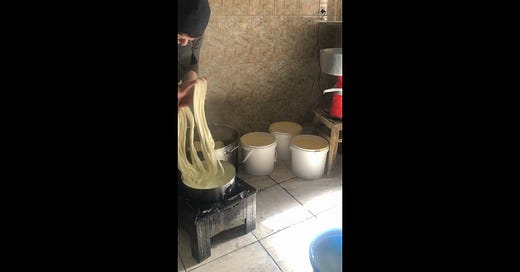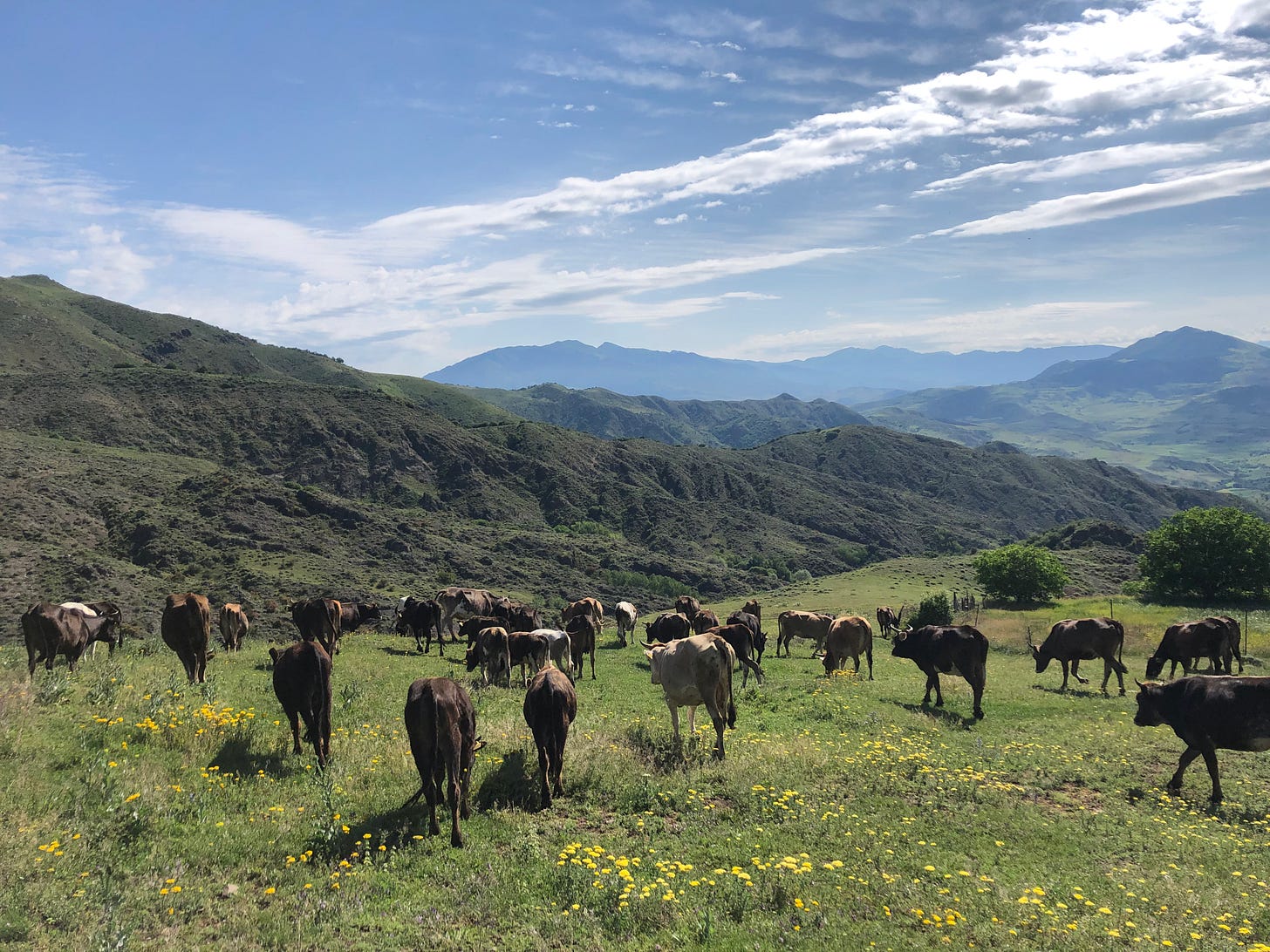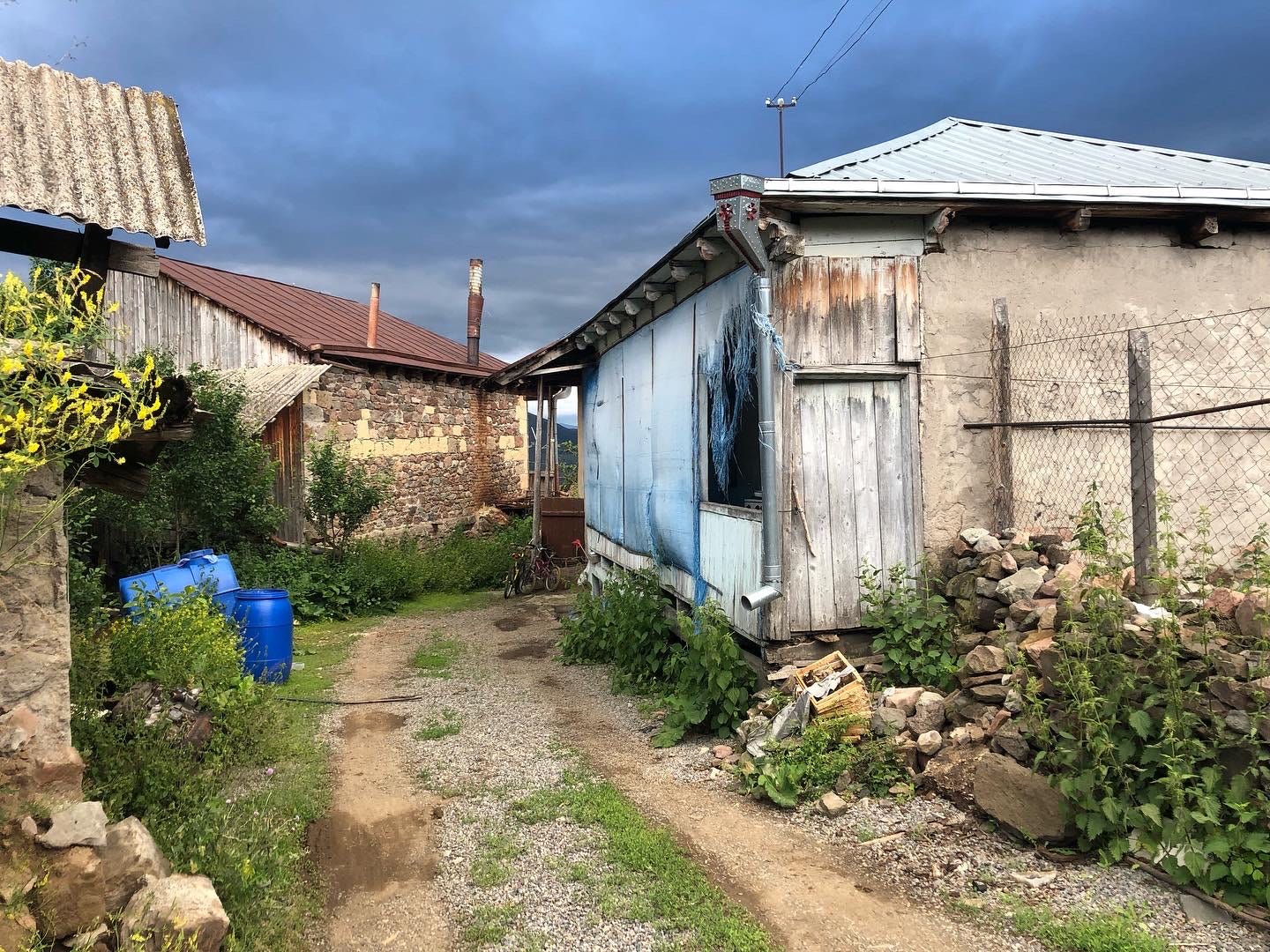In the mountains of Southern Georgia near Turkey, I was invited to stay with a family who makes a unique cheese called Tenili. In 2 villages the cheese is still made according to a technique that has no documented origin, or theory of introduction; it is a cheese of this place and people, an emblem of their culture. It is essentially semi dry threads of cheese mixed with cream and packed in pottery vessels. Yum. I want to discuss its production and then talk a bit about the various materials used in cheese shaping and storing.
Tenili is a stretched curd cheese, no starter is used, the milk is heated to a temperature gauged by hand, set with rennet, cut and stirred then left in baskets overnight to ferment to the proper ph range of 5.4-5. Of course no ph meter is used, and the room is fairly cool. In the morning the curd is tested (in hot water, which can actually be a fairly accurate test for acid development) and when ready, stretched. Up to this point the method is similar to any number of the worlds stretched curd cheeses. I feel that this method has been figured out in many parts of the planet and then moved around through diffusion and adapted.
The curd is placed in hot water until very malleable, made into a ball, that is made into a donut. The donut is elongated through a hand over hand spinning motion, with the curd ribbon going through a container of hot water on the floor. Once it is very long it is doubled up on itself, over and over, until the arms of the maker are holding a coiled, single thin strand of cheese likely over 100 feet long. This is placed in cold salt water briefly, then hung up to dry.
The next day the ropes are pulled apart into very thin threads, like string cheese. These threads are hung on a specialized wood beam and allowed to dry over an unspecified time, and yeasts grows on them. I know yeasts are present due to smell, and this period of yeast growth prior to the final cheese being formed is a theme I have seen in many cheeses. When they are deemed ready, they are covered in cream, and packed into pottery vessels or plastic containers to be sold. Apparently in the past these vessels would be turned upside down onto ash so the liquid could drain, and the cheese aged in this way. This practice sounds remarkably similar to a cheese called Motal, which in one form made in Armenia is put into pottery, upside, on ash.
Storing food and beverages in pottery has a long history in Georgia, most notably in the popular qvevri wines. Grains, oils, and dairy products were and are preserved by placing them in pottery containers partially buried in the ground. There are multiple cheeses I’ve heard of here that use these types of vessels as storage containers. The use of natural materials in cheesemaking or storage appeals to me, it involves a separate local handcraft that has been incorporated into the milk preservation practices. People use what they have around them, and this DIY resourcefulness should be highlighted in an age of global reliance on ubiquitous industrial materials. Stainless steel and plastic molds are seen as signs of progress, by perhaps they are indicative of the decay of local ingenuity, and replacement of something organic with a lifeless product that may carry health risks.
The choice of materials used in cheesemaking vats, the draining forms, and packaging have influences on ripening and the direction of microbial community development. There are cheeses in various places that utilize pottery for ripening, such as the French Saint Félicien. One rind forms on the top of this cheese, with a different rind on the bottom where there is little oxygen. The whole thing can get runny, being held in by the walls. Bark wrapped cheese ( actually Cambium, a particular layer of “bark”) are another. The bark induces a different kind of rind formation under and on its surface, you will often see certain molds growing only on the bark.
Other things that cheese is packed in I see as preforming a role of preventing excessive dehydration. Many people, especially mobile pastoralists, don’t have cellars or cheese caves. One of the oldest families of aged cheeses are those packed into goat/sheep skins, a remarkable adaptation of shepherds who skillfully prepare the hides. Animals skin have pores which in this case serve as semi permeable cheese aging containers with some salty whey escaping. In places the skins have been replaced by wooden boxes (Mishavine in N. Albania) or plastic bags. The most obvious example is cheeses aged in barrels full of brine, a common practice in hot, dry places. Again, the materials these barrels has implications on the cheese microbiology, and human health. The modern move is from wood to plastic.
There is an exemplary effort underway to protect the traditional methods and materials used to make Tenili. Any one interested in Georgian cheese quickly finds visually pleasing videos of its theatrical stretching process. A group called ELKANA is working to promote it, and get a protected name for the cheese. The family I visited in the process of building a larger facility to ramp up production and be able to buy milk from the dairy farms of the whole village. Again I am astounded when I see these things, shocked that this is the method that has been chosen, and by the diversity of approaches to milk fermentation that exist. Milk can be made into such a range of products, as seen in the photo below. It is this diversity and it’s connections to human cultures, food systems, and landscapes, that I am keen to explore and document.













Share this post